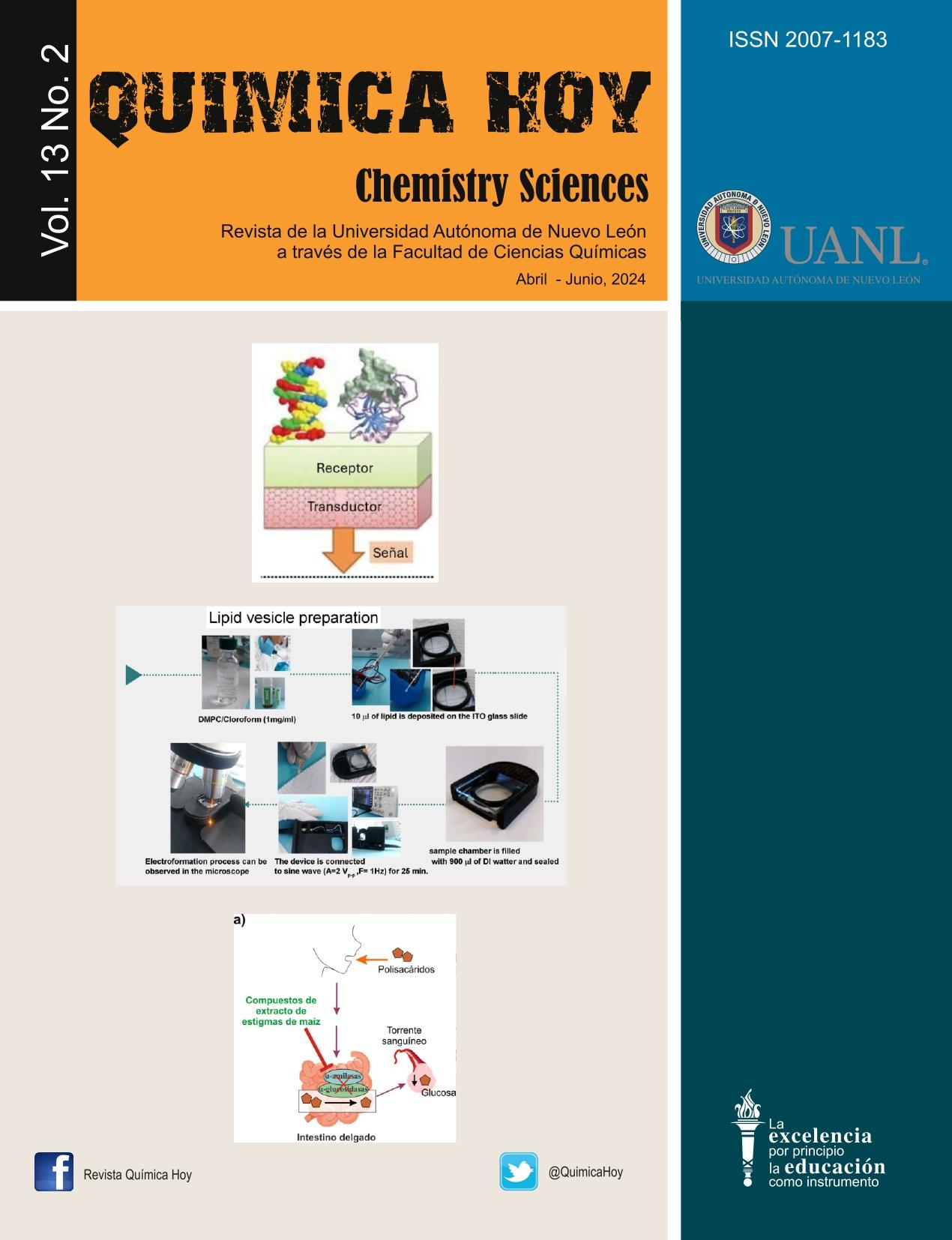Mejora de la Turquesa Gis utilizando Poliepoxido, Poli(metil 2- metilpropinoato)metacrilato y Ultrasonido
DOI:
https://doi.org/10.29105/qh13.02-419Palabras clave:
Ultrasonido, Estabilización, Turquesa, Difracción de rayos-X, Poliepóxido, Propiedades mecánicasResumen
En este estudio, se examina la influencia del ultrasonido en el proceso de estabilización de la turquesa. Se utilizó turquesa de grado "gis", caracterizada por su fragilidad y una apariencia opaca y lechosa. Esta fue sometida a un análisis detallado mediante difracción de rayos X en polvos. El proceso de estabilización se llevó a cabo bajo un vacío de medio a medio alto, lo que permitió desplazar el aire contenido en los poros de la turquesa, sustituyéndolo por una mezcla de resina epóxica y metacrilato. Posteriormente, se realizó el fraguado final utilizando ultrasonido de baja frecuencia. Los resultados obtenidos revelan mejoras significativas tanto en la calidad óptica como en las propiedades mecánicas de la turquesa estabilizada. Este trabajo aporta una comprensión más profunda del papel del ultrasonido en la modificación de materiales frágiles y sugiere nuevas oportunidades para su aplicación en la estabilización de otros minerales con características similares.
Descargas
Citas
- [1]. Abdu, Y. A.,Hull, S. K., Fayek, M., & Hawthorne, F. C. (2011). The turquoise-chalcosiderite Cu(Al,Fe3+)6(PO4)4(OH)8middle dot4H2O solid-solution series: A Mossbauer spectroscopy, XRD, EMPA, and FTIR study. The American mineralogist, 96(10), 1433-1442. https://doi.org/10.2138/am.2011.3658 DOI: https://doi.org/10.2138/am.2011.3658
- [2]. Carò, F., Schorsch, D., Smieska, L., & Santarelli, B. (2021). Non-invasive XRF analysis of ancient Egyptian and near Eastern turquoise:A pilot study. Journal of Archaeological Science, Reports, 36(102893), 102893. https://doi.org/10.1016/j.jasrep.2021.102893 DOI: https://doi.org/10.1016/j.jasrep.2021.102893
- [3]. Ğejka, J., Sejkora, J., Macek, I., Malíková, R., Wang, L., Scholz, R., Xi, Y.,& Frost, R. L. (2015). Raman and infrared spectroscopic study of turquoise minerals. Spectrochimica Acta. Part A, Molecular and Bioniolecular Spectroscopy, 149, 173-182. https://doi.org/10.1016/j.saa.2015.04.029 DOI: https://doi.org/10.1016/j.saa.2015.04.029
- [4]. Dumańska-Słowik, M., Wesełucha-Birczyńska, A., Natkaniec-Nowak, L., Gaweł, A., Włodek, A., & Kulmaczewska, K. (2020). Blue or green? turquoise— planerite species from Carico Lake Valley in Nevada, the United States: Evidence from Ramanspectroscopy. Journal of Raman Spectroscopy. JRS, 51(2), 346-356. https://doi.org/10.1002/jrs.5761 DOI: https://doi.org/10.1002/jrs.5761
- [5]. Fritsch, E., & Rondeau, B. (2009). Gemology: the Developing Science of gems. Elements, 35(1), 4-16.
- [6]. Saeide Jadidi Ardekani, M. A. M. A. F. A. (2020). Mineralogy and Formation Conditions of Turquoise in Ali Ahad Cu Porphyry deposit. 12(1), 93-109. https://doi.org/10.22067/econg.v12iI .72122
- [7]. Caruso, V., Marinoni, N., Diella, V., Berna, F., Cantaluppi, M., Mancini, L., Trombino, L., Cattaneo, C., Pastero, L.,& Pavese, A. (2020). Bone diagenesis in archaeological and contemporary human remains: an investigation of bone 3D microstructure and minero-chemical assessment. Archaeological and Anthropological Sciences, 72(8). https://doi.org/10.1007/s12520-020-01090- 6 DOI: https://doi.org/10.1007/s12520-020-01090-6
- [8]. Della Ventura, G., Capitelli, F., Capitani, G., Ventruti, G., & Monno, A. (2019). X-ray strucmre refinement and vibrational spectroscopy of metavauxite FeAl2(PO4)2(OH)2*8H2O. Crystals, 9(6), 297. https://doi.org/10.3390/cryst9060297 DOI: https://doi.org/10.3390/cryst9060297
- [9]. Feldkamp, L. A., Davis, L. C.,& Kress, J. W. (1984). Practical cone-beam algorithm. Journal of the Optical Society of America. A, Optics, Image Science, and Vision, 7(6), 612. https://doi.org/10.1364/josaa.1.000612 DOI: https://doi.org/10.1364/JOSAA.1.000612
- [10]. Fritsch, Emmanuel, McClure, S. F., Ostrooumov, M., Andres, Y.,Moses, T., Koivula, J. I.,& Kammerling, R. C. (1999). The identification of Zachery-treated turquoise. Gems & gemology, 35(1), 4-16. https://doi.org/10.5741/gems.35.1.4 DOI: https://doi.org/10.5741/GEMS.35.1.4
- [11]. Hainschwang, T.,& Notari, F. (2008). Specular Reflectance Infrared Spectroscopy-a review and update of a little exploited method for gem identification. J Genirnol, 31, 23- 29. DOI: https://doi.org/10.15506/JoG.2008.31.1.23
- [12]. Han, W., Lu, T., Dai, H., Su, J., & Dai, H. (2015). Impregnated and Dyed Turquoise. Gems Gemol, 51, 343- 345.
- [13]. Hole F, Flannery KV, Neely JA (1969) Prehistory and Human Ecology of the deh luran plain: an early village sequence from Khuzistan, Iran. University of Michigan Press. https://doi.org/10.3995/mpub. 11395 036 DOI: https://doi.org/10.3998/mpub.11395036
- [14]. Schwarzinger, B.,& Schwarzinger, C. (2017). Investigation of turquoise imitations and treatment with analytical pyrolysis and infrared spectroscopy. Journal of analytical and applied pyrolysis,125, 24-31. https://doi.org/10.1016/j.jaap.20 17.05.002 DOI: https://doi.org/10.1016/j.jaap.2017.05.002
- [15]. Kwon, K. R.,Bang, S. Y., Park, J. W., & Shim, K. B. (2009). Structural characteristics of Zachery-treated turquoise.J Korean Cry Growth Cry Tec, 19, 95-101.
- [16]. Mcclure, S. F., Kane, R. E., & Sturman, N. (2000). Gemstones enhancement and its detection in the 2000s. Gems Gemol, 46,218-240. DOI: https://doi.org/10.5741/GEMS.46.3.218
- [17]. Sabbaghi, H. (2018).A combinative technique to recognise and discriminate turquoise stone. Vibrational Spectroscopy, 99, 93-99. https://doi.org/10.1016/j.vibspec.2018.09.002 DOI: https://doi.org/10.1016/j.vibspec.2018.09.002
- [18]. Shigley, J. E., & McClure, S. F. (2009). Laboratory-treated gemstones. Elements (Quebec, Quebec), 5(3), 175-178. https://doi.org/10.2113/gselements.5.3.175 DOI: https://doi.org/10.2113/gselements.5.3.175
- [19]. Lind, T., Schmetzer, K., & Bank, H. (1983). The identification of turquoise by infrared spectroscopy and x-ray powder diffraction. Gems & gemology, 19(3), 164-168. https://doi.org/10.5741/gems.19.3.164 DOI: https://doi.org/10.5741/GEMS.19.3.164
- [20]. Sun, L. H., Ling, A., Yu, F., He, Z., & Ma, W. (2014). A tentative discussion on Zachery-treated turquoise. Acta Petr Miner, 33,165-171.
- [21]. Latif, D. 0. (2024). Effect of epoxy resin and cement as grout on the mechanical properties of silt. International journal of GEOMATE, 26(115). https://doi.org/10.21660/2024.115.4186 DOI: https://doi.org/10.21660/2024.115.4186
- [22]. Ghasemzadeh, H.,Mehrpajouh, A.,& Pishvaei, M. (2021). Laboratory analyses of Kaolinite stabilized by vinyl polymers with different monomer types. Engineering Geology, 280(105938), 105938. https://doi.org/10.1016/j.enggeo.2020.105938 DOI: https://doi.org/10.1016/j.enggeo.2020.105938
- [23]. Atiqah, A., Ansari, M. N. M., & Premkumar, L. (2020). Impact and hardness properties of honeycomb natural fibre reinforced epoxy composites. Materials Today: Proceedings, 29, 138-142. https://doi.org/10.1016/j.matpr.2020.05.645 DOI: https://doi.org/10.1016/j.matpr.2020.05.645
- [24]. Sprenger, S. (2020). Nanosilica-toughened epoxy resins. Polymers, 12(8), 1777. https://doi.org/10.3390/polym12081777 DOI: https://doi.org/10.3390/polym12081777
- [25]. Qi, B., Zhang, Q. X.,Bannister, M.,& Mai, Y.-W. (2006). Investigation of the mechanical properties of DGEBA-based epoxy resin with nanoclay additives. Composite Structures, 75(1-4), 514-519. https://doi.org/10.1016/j.compstruct.2006.04.032 DOI: https://doi.org/10.1016/j.compstruct.2006.04.032
Descargas
Publicado
Cómo citar
Número
Sección
Licencia
Derechos de autor 2024 Francisco J. Garza, Juan de Dios Ruiz , Tomás C. Hernández García

Esta obra está bajo una licencia internacional Creative Commons Atribución 4.0.





